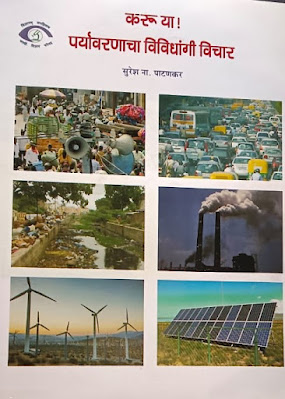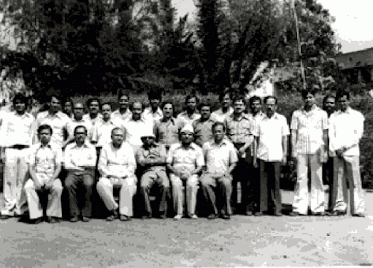A memorable story of my stay at IIT, Kanpur and research under his guidance -II
It was the period
political turmoil in India. Although
Kanpur IIT was funded by the US, the students were dominated by the Left
Communists in West Bengal. The magazines and newspapers that came to the
library were from left parties. There were some RSS students and staff but
their numbers were very small. Dr. Jayaprakash Narayan's agitation had started.
Students were hypnotized by concept of total revolution. Dr. Subrahmanyam Swami
Former Vice Chancellor of Shivaji University Dr. Dhanagare were in the IIT at the same time. In
our Environment department,Dr. Agrawal and Malay Chaudhary were Hindi speakers
from Uttar Pradesh and Bangal, while Prabhakarrao, Venkobochar, Iyengar,
Dayaratnam, etc. were English speakers from South India. Maharashtrian Bokil was
the only Marathi professor and he wanted to get along with both the groups
(later he committed suicide due to promotion issue.) Agrawal was also kept away
from other professors due to his strict nature. (I learned from his letter that
this was the reason for his leaving the
directorship.)
I had to live in the hostel for the first
term. In the next tem I got shared quarters and we (with Shubhangi and two and
a half year old Sumedha) started living with a Bengali family. Basu Roy was
doing his PhD in Mechanical and was a staunch left communist. We had a kitchen
and bedroom whereas main hall and a room
belonged to him. He had son as our Sumedha. Though our political views were
extreme, we were at peace at home. There were movements against the student
director. Their night meetings were a way to attract students to the communist
student. Even my closest friend had become a communist by following his diet.
Most of the disciplinary work in IITs had to be done by Agrawal. (Later he
became the student dean) The students did not like his strict discipline. Some
professors from the south seduce students.
In Kanpur at that
time there were only two groups, the very poor and the very rich. Bullying and
murder were commonplace. In our IIT campus also, there was obe incidence where one
person was shot dead in a social outdoor gathering. The tempo by which we used
to go to Kanpur (at a distance of 13 km) often had some passenger with gun.
Nobody cared about life. At night, Hynas gang lift away the sleeping children
from slum dwellers. I, too, had escaped once from the the hyna following my
bicycle while going home from the library at night.
The banks of the
Ganges were a crowded with slums,
uncleanliness and crime. Agrawal was trying to improve this situation with
social agencies. Dr. Agarwal used to take us to the surrounding rural villages
for participating in the cleaning and education programs of the schools and
community centers there. IIT had adopted a village for development. English
speaking professors from South India did not participate. The northern
professors complained that they were ignored in promotions because of their
lack of English and insistence on Hindi.
Although Dr. Agrawal
had came from the US with a PhD, he did not like computers at all. He had given
me such strong warning for not using computers. He was of the opinion that if one
did the calculations himself, he would understand better than the computer
answer.
I, however, had a
strong fascination with computers there. My Marathi friends used to come to our
house in the evening. Most of them worked on computers. With their help, I used
to go to the computer lab at night. Our neighbor Mrs. Athavale was employed in
a computer lab and I got admission there through her acquaintance. By punching
the cards, one card for each sentence, a bundle of cards was given to the
computer lab operator just as we give floor to grain mill After one or two days
all the bundles of cards with output paper rolls were distributed. Wrong cards had to be punched again. Some people
deliberately made mistakes when they saw that they get blank papers. After
realizing this, a programmer was
appointed to check the program before feeding to computer.
Dr. G. D. Agrawal
did not like to do research in the laboratory or on theoretical subjects. Shri
Jayant Kardile had constructed Dual
Media Filter at Nasik using crushed coconut shell. Dr. Agrawal suggested to use
crushed apricot shells, which were abundant in supply in Uttar Pradesh,. So I did
research on experimental filters and published the paper. We knew that
anthracite was used for dual media abroad but it was not available in India.
Since low quality coal was being used in households in North India and was the
cause of domestic air pollution, our
attention was drawn to the physical properties of this coal and the experiment
proved that it would be suitable for filters.
Then Dr. Agrawal
asked me to study process at Kanpur. As per his advice, I used to go to Kanpur
Waterworks every morning with Tiffin box and study all the systems there and test the
water samples. In the afternoon, we used to take lunch with the workers in the filter house.
Keeping in touch with the workers, chemists and engineers throughout the day
gave me a thorough understanding of all the technical as well as social
conditions there. I have closely watched the plight of the workers. They used
to have barley bread, onion and wet gram dal, onion and chilli in the box. Engineers behaved very
harshly with them.
The Chief
Engineer Shri. Y. D. Mishra was very strict with subordinates. He used to go
round all the plant with me every morning. He kept the plant equipment clean
and in working condition. His house was in the plant area. All the household works were done by waterworks staff. Mishra used to
invite outside guests and took pride in introducing me as IIT research scholar.

















